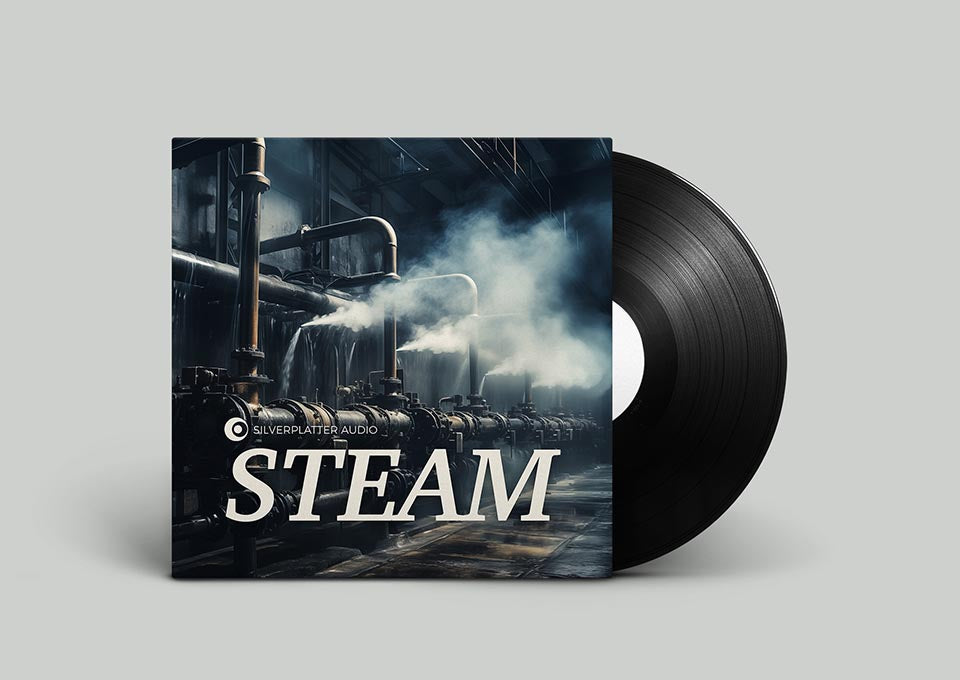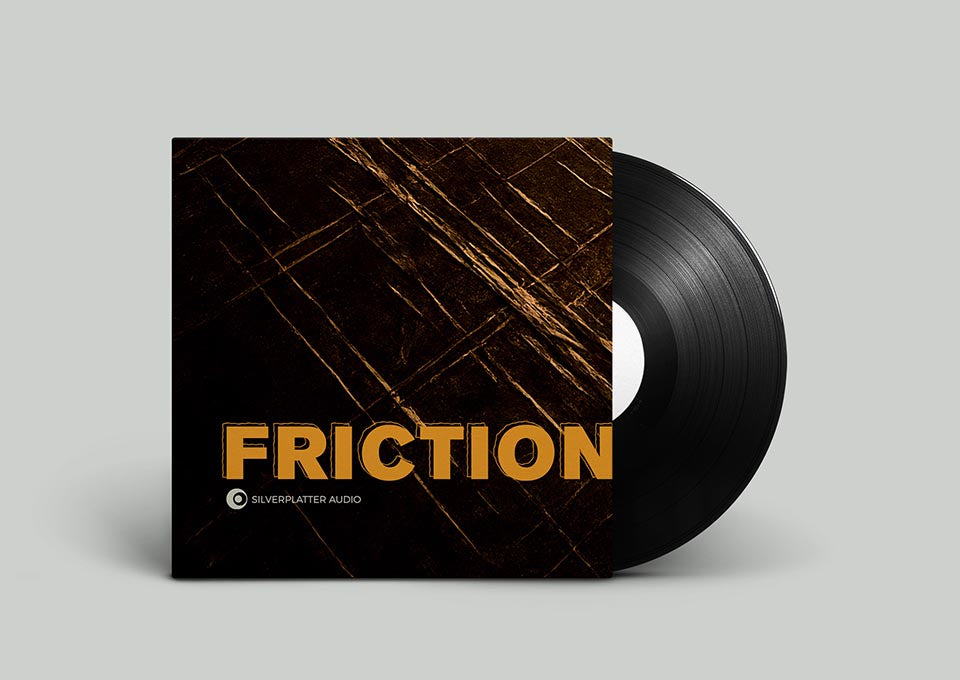A
ADSR (Attack, Decay, Sustain, Release)
ADSR is an envelope model used to control the dynamic shape of a sound. It defines how a sound evolves over time, from its initial attack to how it fades out.
- Attack: This is the initial phase, representing the time it takes for the sound to rise from silence to its peak amplitude. A short attack time produces a sharp, percussive start, while a longer attack creates a more gradual and smoother onset.
- Decay: Following the attack, the decay phase determines how quickly the sound decreases from its peak to the sustain level. This phase is crucial for shaping the perceived sharpness or softness of a sound.
- Sustain: Unlike the other phases, sustain represents a level, not a time. It defines the amplitude at which the sound holds after the decay and during its main duration, such as the steady tone of a note held on a keyboard.
- Release: This final phase controls how the sound fades away once the note or sound is released. A short release results in an abrupt end, while a longer release creates a smoother fade-out.
Algorithmic Reverb
Algorithmic reverb is a type of reverb generated by algorithms that simulate the reflections of sound in a virtual space. Unlike convolution reverb, which uses real impulse responses, algorithmic reverb is synthesized, offering more control over parameters like decay time, diffusion, and size for creative sound design.
Aliasing
Aliasing in digital audio occurs when a sound being recorded contains frequencies higher than the Nyquist frequency of the recording device, which is half its sampling rate. These high frequencies cannot be accurately represented when sampled due to the system's limitations. Instead, they 'fold back' into the audible range as incorrect lower frequencies, causing distortion known as aliasing.
To prevent aliasing, recording systems typically use an anti-aliasing filter to remove frequencies higher than the Nyquist frequency before the audio is digitized. This ensures that problematic high frequencies do not interfere with the digital recording.
Ambience
Ambience refers to the background sound that provides a sense of atmosphere or environment in audio. It’s often used in sound design to enhance the realism or emotional tone of a scene. Common ambient sounds include wind, city noise, or natural environments like forests or oceans.
Amplitude
Amplitude represents the strength or loudness of an audio signal. In sound design, controlling amplitude is key to balancing elements in a mix, ensuring that certain sounds stand out while others blend into the background. It’s essential for achieving dynamic variation in both music and sound effects.
Amplitude Modulation (AM)
Amplitude modulation involves varying the amplitude of one sound signal with another. In sound design, AM is used to create complex textures, rhythmic variations, or tremolo effects by modulating the loudness of a sound over time, adding depth and movement to audio.
Artifacts
Artifacts are unintended sounds or distortions introduced during audio processing, such as compression, time-stretching, or digital conversion. In sound design, minimizing artifacts is essential for maintaining the integrity of the sound, though sometimes they are used creatively to achieve specific effects.
ASMR (Autonomous Sensory Meridian Response)
ASMR is a sensory phenomenon triggered by specific sounds like whispering, tapping, or soft brushing, often recorded binaurally to create a 3D effect. In sound design, ASMR is used to evoke relaxing or tingling sensations, popular in audio content for its immersive and calming qualities.
Attack
Attack is the initial part of a sound’s envelope, defining how quickly the sound reaches its peak amplitude after it’s triggered. In sound design, controlling the attack is essential for shaping the character of a sound, whether it’s a fast, sharp hit or a slow, gradual rise.
Attenuation
Attenuation refers to the reduction in the intensity of a sound signal. Attenuation is used to lower specific frequencies or overall levels in a mix, helping maintain balance, prevent distortion, and ensure clarity. It’s commonly applied in EQ, noise reduction, and mixing. In game audio engines like Wwise, attenuation is also used to simulate how sound diminishes over distance, enhancing realism and immersion in interactive environments.
Audio Spectrum
The audio spectrum is the range of frequencies that can be heard by humans, typically represented by being from 20 Hz to 20,000 Hz. With normal aging, our hearing loses the ability to perceive higher frequency ranges over time. In sound design, managing the audio spectrum allows designers to manipulate the balance of bass, mids, and treble, creating a fuller and more cohesive sound.
B
Binaural Audio
Binaural audio is a recording technique that uses two microphones to simulate human hearing, creating a 3D sound experience when listened to on headphones. This technique is often used in immersive sound design, VR, and ASMR recordings.
Bit Depth
Bit depth refers to the number of bits used to represent each audio sample in digital recording. A higher bit depth allows for greater dynamic range and finer detail in sound, making it important for achieving high-quality audio in sound design. A higher bit rate also helps maintain audio quality when using various processing techniques.
Boominess
Boominess describes excessive low-frequency energy in an audio signal, often causing a muddy or unclear sound. It can be caused by poor room acoustics or improper microphone placement. Boominess can be reduced using EQ to enhance clarity in a mix.
Buffer Size
Buffer size in audio processing refers to the amount of time allocated for a computer to process audio data before playback. Smaller buffer sizes reduce latency but increase CPU load, while larger buffer sizes can cause playback delays but ease processing.
Bypass
Bypass refers to the process of temporarily disabling an audio effect or processor, allowing the original, unaffected sound to pass through. Sound engineers use bypassing to compare processed and unprocessed audio, ensuring the applied effect is beneficial to the mix.
C
Channel
A channel refers to a distinct audio pathway in a mixer or digital audio workstation (DAW) where sound signals are processed independently. Channels allow mixers or sound designers to manipulate individual audio tracks, apply effects, and control levels to achieve a balanced mix.
Chorus
Chorus is an audio effect that creates the illusion of multiple voices or instruments playing simultaneously by slightly delaying and modulating the sound. This thickens the audio signal and adds richness and depth, making it popular in music production and sound design.
Clipping
Clipping occurs when an audio signal exceeds the maximum level that can be accurately reproduced, resulting in distortion. This effect can be intentional for creative purposes or unintentional, leading to undesirable sound quality. Sound designers must monitor levels to avoid unintentional clipping.
Compression
Compression is a dynamic processing technique that reduces the volume of loud sounds and amplifies quieter ones. It helps maintain a consistent audio level, enhancing clarity and impact in sound design. Compression is essential in mixing to ensure balanced audio across different elements.
Creak Box
A creak box is a specialized sound effects tool designed to produce and perform creaking and squeaking noises. Inside a wooden frame, a rope is attached to an eye bolt, which can be turned to add tension to a rotating component. As more tension is applied, the rotating piece creates friction with the frame, resulting in increasingly intense creaks and squeaks. More info here.
Crescendo
A crescendo is a gradual increase in loudness or intensity within a sound or musical passage. It is often used to build tension and anticipation in audio design, guiding the listener’s emotional response. Crescendos can be effective in film scoring and sound effects.
Cutoff Frequency
Cutoff frequency is the point at which a filter begins to affect an audio signal, determining which frequencies are attenuated or allowed to pass. Understanding cutoff frequencies is crucial for sound designers to shape and sculpt sound, particularly in equalization and filtering processes.
Cymatics
Cymatics is the study of visible sound and vibration, often demonstrated through patterns created by sound waves interacting with a medium like sand or water. This concept can inspire sound designers to explore the visual representation of sound, leading to creative audio and visual projects.
D
DAW (Digital Audio Workstation)
A DAW is software used for recording, editing, and producing audio. It provides sound designers with tools to manipulate audio tracks, add effects, and mix soundscapes. Popular DAWs include Pro Tools, Ableton Live, Reaper, Nuendo, Cubase, Studio One, and Logic Pro, essential for modern sound design workflows.
Decay
Decay refers to the part of a sound’s envelope where the amplitude decreases after the initial attack. In sound design, controlling decay helps shape the texture and duration of a sound, allowing designers to create smooth fades or more abrupt drop-offs, depending on the desired effect. It can also refer to to the length of fade time that a reverb effect gives.
De-esser
A de-esser is an audio tool used to reduce or eliminate harsh sibilance sounds, like "s" and "sh" in vocal recordings. It’s essential in sound design and audio mixing to ensure clear, natural-sounding speech without excessive high-frequency noise that can cause discomfort to listeners.
Delay
Delay is an audio effect that records an input signal and plays it back after a specified period, creating a repeated sound. It can range from a quick slap-back echo to longer, more complex repetitions. In sound design and music production, delay is used to add depth, create spatial effects, and enhance rhythmic patterns. The effect can be manipulated through various parameters, including time, feedback (the number of repetitions), and mix level, allowing sound designers to craft unique auditory experiences and enrich the overall sound.
Demo Reel
A sound design demo reel is a video or collection of videos showcasing your sound design abilities, offering the best opportunity to impress potential employers. In reality, a sound design résumé without a demo reel is most likely to be overlooked.
Directivity
Directivity refers to how sound radiates from a source in different directions. In sound design, understanding directivity helps designers capture and place sounds accurately in a stereo or surround mix, allowing for a more immersive listening experience. It’s essential for achieving realistic soundscapes in film and gaming.
Distortion
Distortion is an effect that alters the original sound signal by adding harmonic or non-harmonic overtones, creating gritty, aggressive, or textured sounds. In sound design, analog distortion typically produces warmer, smoother results due to the natural saturation of hardware circuits like tube amps and tape machines. In contrast, digital distortion can be harsher and more precise, as it results from clipping in the digital domain. While analog distortion is often valued for its organic character, digital distortion offers more control and versatility, depending on the artistic intention of the sound designer.
Dither
Dither is a process used in digital audio (known as dithering) to minimize quantization errors when reducing bit depth or converting audio formats. By adding low-level noise, dither helps maintain audio quality and prevent unwanted artifacts. Sound designers use dither to ensure that audio remains clean and smooth during processing and playback.
Doppler Effect
The Doppler Effect is a change in frequency or pitch as a sound source moves relative to a listener. Sound designers use this effect in games, films, and simulations to create realistic motion sounds, such as passing vehicles or flying objects, adding depth and immersion to the audio experience.
Drive
Drive refers to the amount of gain or saturation applied to an audio signal, often associated with analog distortion effects. In sound design, adjusting drive can enhance the character and warmth of sounds, giving them more presence in a mix. It’s commonly used with guitar amps, synthesizers, and various audio plugins to add richness and texture.
Dynamics
Dynamics refer to the variations in loudness and intensity within a sound or audio mix. Understanding and manipulating dynamics is crucial for sound designers, as it enhances the emotional impact and clarity of audio. Techniques like compression and expansion are often used to control dynamics in sound design.
E
Echo
Echo is a sound that reflects off of a surface or surfaces and is heard again after a delay. In sound design, echo is often used creatively to add depth and space to audio. It can simulate natural environments, enhance vocals, or create atmospheric effects, significantly contributing to the overall feel of a soundscape. Echo is also commonly referred to as delay and is widely utilized in music production to create rhythmic patterns and rich sonic textures.
Effects Chain
An effects chain is a series of audio effects applied to a sound signal in a specific order. In sound design, the arrangement of effects—such as reverb, delay, and distortion—can significantly impact the final sound. Understanding how to construct and manipulate effects chains is essential for achieving desired audio textures and atmospheres.
Elastic Audio
Elastic Audio is a feature found in some digital audio workstations that allows for real-time time-stretching and pitch-shifting of audio recordings. This tool enables sound designers to manipulate recorded audio easily, adjusting timing and pitch without degrading sound quality, which is essential for creating rhythmic and melodic elements.
Emitter
An emitter is a virtual or physical sound source used in audio production or game audio. Emitters can represent a range of sounds, from a focused point source to more diffuse environmental ambience. Proper placement and management of emitters are essential for crafting immersive audio experiences in both games and film.
Envelope
An envelope defines how a sound evolves over time, typically described by four stages: Attack, Decay, Sustain, and Release (ADSR). In sound design, manipulating envelopes allows designers to shape the dynamic characteristics of sounds, influencing their articulation and expressiveness in music or sound effects.
Equalization (EQ)
Equalization, or EQ, is the process of adjusting the balance and/or gain of specific frequency ranges within an audio signal. Sound designers use EQ to enhance or reduce frequencies to improve clarity, eliminate unwanted noise, and create space in a mix. Effective EQ is crucial for achieving a polished and professional sound.
Export
Export refers to the process of rendering or saving a project’s audio files into a specific format, such as WAV, MP3, or AIFF. In sound design, exporting is essential for delivering finalized audio for distribution or integration into other media. Proper export settings ensure that the audio retains quality and compatibility across different platforms.
F
Feedback
Feedback occurs when a portion of an audio signal is returned to its source, often creating a loop that can amplify the sound. In delay effects, feedback refers to the amount of the delayed signal that is sent back into the input, creating cascading repetitions. This allows for longer, evolving echoes that can build intensity over time. However, uncontrolled feedback can lead to undesirable loudness or distortion, making it crucial to manage carefully in both live settings and recordings to ensure a balanced audio experience.
Filter
A filter is an audio processing tool used to alter the frequency content of a sound signal by attenuating or boosting specific frequency ranges. Filters come in various types, including low-pass, high-pass, band-pass, comb and notch filters.
Flanging
Flanging is an audio effect that creates a unique, sweeping sound by mixing two identical signals with a slight delay and modulating that delay over time. This effect produces a series of peaks and troughs in the frequency spectrum, resulting in a characteristic whooshing sound. Flanging is often used in music and sound design to add depth and movement to audio tracks.
Foley
Foley is the art of creating and recording sound effects that synchronize with visual media, enhancing the auditory experience. These sounds, such as footsteps, rustling clothing, and ambient noises, are typically recorded in a studio to match the action on screen. Foley can be used in film, television, and video games.
Frequency
Frequency refers to the number of cycles of a sound wave that occur in one second, measured in Hertz (Hz). It determines the pitch of a sound, with higher frequencies corresponding to higher pitches and lower frequencies to lower pitches.
Frequency Modulation (FM)
Frequency modulation (FM) is a synthesis technique that alters the frequency of a carrier wave based on the amplitude of a modulating signal. This method can create a wide range of complex sounds, from simple tones to rich textures. FM synthesis is widely used in sound design for producing unique timbres and is particularly popular in electronic music production.
G
Gain
Gain refers to the increase in amplitude of an audio signal, which directly affects its loudness. In sound design, adjusting gain is crucial for balancing levels, ensuring that sounds are neither too quiet nor too loud. Proper gain staging throughout the recording and mixing process helps prevent distortion and maintains audio clarity.
Gated Reverb
Gated reverb is a reverb effect that is applied to a sound but is abruptly cut off after a certain threshold level, creating a distinct, punchy sound. This effect is commonly used in music production, especially in the 1980s, to enhance drums and create a spacious feel without muddying the mix.
Generative Sound
Generative sound refers to audio created by algorithms or processes rather than through traditional recording methods. This approach can produce unique, evolving soundscapes and textures, often used in ambient music, installations, and interactive media. Generative sound design allows for endless variations and spontaneity, making it a fascinating area for exploration.
Glissando
Glissando is a musical technique that involves sliding smoothly between pitches, creating a continuous transition rather than distinct notes.
Granular Synthesis
Granular Synthesis is an audio synthesis technique that breaks down sound into small fragments called "grains," typically ranging from a few milliseconds to a few seconds in length. These grains can then be manipulated and reassembled to create new sounds or textures. Granular synthesis allows for a high degree of control over various parameters, such as grain size, playback speed, pitch, and position in the sound field. This technique is particularly effective for creating complex, evolving soundscapes, time-stretching audio, or transforming existing recordings into unique sonic textures. It is widely used in electronic music, sound design, and experimental audio applications.
H
Harmonics
Harmonics are the overtones that accompany a fundamental frequency in a sound wave. They are integer multiples of the fundamental frequency and contribute to the timbre and richness of a sound.
Headroom
Headroom refers to the difference between the maximum level of an audio signal and the point at which distortion occurs, typically measured in decibels (dB). It indicates how much space is available before an audio signal clips or distorts when amplified or processed.
Hertz (Hz)
Hertz (Hz) is the unit of measurement for frequency, representing the number of cycles per second of a sound wave.
High-Pass Filter
A high-pass filter is an audio processing tool that allows frequencies above a certain cutoff point to pass through while attenuating lower frequencies. In sound design, high-pass filters are commonly used to remove unwanted low-end rumble or noise, helping to create a cleaner mix and maintain clarity in audio recordings.
Hum
Hum is a low-frequency noise often caused by electrical interference or grounding issues. It can manifest as an unwanted background sound in recordings and can detract from audio clarity. In sound design, removing hum often requires techniques like filtering or noise reduction during the mixing process.
Harmonic Distortion
Harmonic distortion occurs when an audio signal is altered in a way that introduces additional harmonics, often due to clipping or the saturation of an audio signal. While typically viewed as an undesirable effect, some sound designers intentionally use harmonic distortion to add warmth and character to sounds, especially in music production.
I
Impedance
Impedance refers to the resistance an audio signal faces as it moves through a circuit. Correctly matching impedance is important when connecting microphones and speakers to amplifiers and audio interfaces. Proper impedance matching optimizes sound quality and helps avoid signal loss or distortion.
Interpolation
Interpolation is a process used in audio signal processing to estimate or generate intermediate values between discrete samples. In sound editing, interpolation helps create smooth transitions between audio segments without noticeable artifacts.
J
Jitter
Jitter refers to small, rapid variations in the timing of audio signals, often caused by digital clock inaccuracies. Jitter can lead to artifacts and distortions in audio playback. Minimizing jitter is important for maintaining audio fidelity.
L
Latency
Latency refers to the delay between an audio signal being input and its corresponding output. In sound design, low latency is crucial for real-time processing, particularly in live performances and recording situations. High latency can lead to timing issues, making it essential for sound enginers to optimize their setups to minimize delays.
Layering
Layering is combining multiple audio tracks or sounds to create a richer, more complex final product. In sound design, layering can enhance depth and texture, allowing designers to build complex arrangements by blending different elements, such as instruments, effects, and field recordings.
LFO (Low-Frequency Oscillator)
An LFO is a signal generator used in synthesizers to create low-frequency waveforms that modulate various parameters, such as pitch, volume, or filter cutoff. In sound design, LFOs add movement and variation to sounds, enabling designers to create evolving textures and dynamic audio effects.
Limiter
A limiter is an audio processing tool that prevents a signal from exceeding a specified level, effectively controlling the maximum output to avoid distortion or clipping. Limiters are great at enhancing a mix loudness without compromising audio quality, making them an essential tool in a typical mastering chain.
Loop
A loop is a repeating segment of audio that can be used to create rhythm, melody, or texture in music and sound design. Loops are commonly used in various genres and can range from simple drum patterns to complex musical phrases. Sound designers often use loops to build compositions quickly and effectively.
Loudness
Loudness is the perceived intensity or volume of a sound, which can vary depending on frequency and context. In post-production, loudness is often measured in Loudness Units (LU), which provide a standardized way to quantify perceived loudness. This measurement is used for achieving consistent audio levels across different platforms and formats, ensuring that the final product meets industry standards. By using LU measurements, sound mixers can adjust dynamic range and maintain a cohesive listening experience, whether for film, games, or music streaming. Proper loudness management is vital for avoiding abrupt changes in volume that could distract or discomfort the listener.
Low-Pass Filter
A low-pass filter is an audio processing tool that allows frequencies below a certain cutoff point to pass through while attenuating higher frequencies. In sound design, low-pass filters are useful for removing unwanted high-frequency noise, creating warmth in sounds, and shaping audio elements to fit within a mix.
M
Mastering
Mastering is the final stage of audio production, where a mixed track is prepared for distribution. This process involves fine-tuning the overall sound by adjusting levels, applying compression, and enhancing tonal balance to ensure that the audio translates well across various playback systems. The goal of mastering is to achieve a polished, cohesive sound that meets industry standards and maximizes the listening experience for the audience.
MIDI (Musical Instrument Digital Interface)
MIDI is a protocol that allows electronic musical instruments and devices to communicate with each other. MIDI is used to control synthesizers, samplers, and software instruments. It allows for precise control over various parameters, such as pitch, velocity, and modulation.
Mixing
Mixing is the process of blending multiple audio tracks into a unified final product. It includes adjusting levels, panning, equalization, and applying effects to achieve clarity and balance among all elements.
Modular Synthesizer
A modular synthesizer is a type of synthesizer composed of separate modules that can be interconnected in various configurations. In sound design, modular synthesizers offer extensive creative flexibility, allowing designers to build unique sounds by combining oscillators, filters, and effects. This hands-on approach encourages experimentation and exploration.
Modulation
Modulation refers to the variation of a sound's parameters over time, such as pitch, volume, or filter cutoff. In sound design, modulation is used to create movement within sounds, enhancing their complexity and expressiveness.
Mono
Mono refers to a single audio channel, as opposed to stereo, which uses two channels. In sound design, mono recordings can provide a focused sound experience, often used for voiceovers. Understanding when to use mono versus stereo is important for creating clarity and impact in audio productions.
On Sale Now
N
Noise Floor
The noise floor is the measure of ambient sound present in an audio recording or system when no intentional sound is being produced. It represents the baseline level of noise, typically caused by electronic components, environmental factors, or the recording medium itself. The noise floor sets the limit for how quiet sounds can be recorded without being drowned out by background noise. A lower noise floor allows for greater dynamic range and clarity in audio, enabling sound recordists to capture the most subtle details.
Noise Gate
A noise gate is an audio processor that reduces unwanted background noise by cutting off sounds below a specified threshold. In post production, noise gates can be used to enhance clarity by eliminating low-level sounds during quiet passages.
Noise Reduction
Noise reduction is a process that minimizes unwanted background noise in recordings. It allows desired sounds to stand out without interference from environmental noise or artifacts. This often involves specialized denoising tools, such as iZotope RX, which use algorithms to analyze and remove noise while preserving the integrity of the original sound.
Nominal Level
The nominal level is the ideal signal level at which audio equipment operates most efficiently. Keeping the signal at this level helps ensure that it is strong enough to avoid noise but not so high that it causes distortion or clipping.
Normalization
Normalization is the process of adjusting the amplitude of an audio signal so that its peak level reaches a specified maximum, typically 0 dB. In sound design, normalization ensures consistency across tracks by allowing all audio elements to be at comparable levels, which aids in creating a balanced listening experience. This process makes it easier to mix different sources without drastic volume changes.
Nyquist Frequency
The Nyquist Frequency is the highest frequency that can be accurately captured by a digital recording device, which is half of its sampling rate. This concept comes from the Nyquist-Shannon sampling theorem, which states that to accurately reproduce a sound, the sampling rate must be at least twice the frequency of the highest sound in the recording. If you record audio at a sampling rate of 44.1 kHz (commonly used for CDs), the Nyquist frequency is half of that, or 22.05 kHz. This means that the highest frequency that can be accurately captured is 22.05 kHz. Any frequencies higher than that will cause aliasing, where high-frequency sounds are misrepresented as lower-frequency sounds, distorting the audio.
O
Oscillator
An oscillator is a device or software component that generates periodic sound waves, such as sine, square, or sawtooth waves. By altering the frequency, shape, and amplitude of the waves, oscillators produce different tones and timbres, which can be further shaped with filters and effects to create a wide variety of sounds—from simple tones to complex, evolving textures. Oscillators can also be used as controllers to modulate almost any parameter in a synthesizer as well as within DAWs.
Overdrive
Overdrive is an audio effect that simulates the distortion created when an amplifier is pushed beyond its limits. It adds warmth, grit, and harmonic saturation to a sound, often giving it a more aggressive or powerful tone.
Overtones
Overtones are higher frequencies that naturally occur above a fundamental tone, contributing to the timbre of a sound. Managing overtones can shape the character of a sound, making it brighter, warmer, or more resonant, depending on how they interact with the fundamental frequency.
Out of Phase
Out of Phase refers to a condition where two sound waves have their peaks and troughs misaligned, meaning that when one wave's amplitude is at a maximum, the other wave's amplitude is at a minimum. This misalignment can lead to partial or complete cancellation of sound when the waves are combined, affecting the overall audio quality.
P
Panning
Panning is the process of distributing a sound signal across a stereo or surround sound field, allowing sound designers to create a sense of spatial depth and directionality in their audio mixes. By adjusting the pan control, sound can be positioned anywhere from left to right (in stereo) or even throughout a three-dimensional space (in surround sound). Effective panning helps create a more immersive sound environment, making it easier for audiences to perceive different elements in a mix, such as instruments or sound effects, and contributes to the overall balance of the audio.
Parabolic Microphone
A type of microphone that uses a parabolic reflector to concentrate sound waves onto a receiver, similar to how a satellite dish directs radio waves to an antenna. This design allows for capturing distant or quiet sounds with greater clarity, making it ideal for wildlife recording.
Parametric EQ
Parametric EQ (Equalization) is a sophisticated type of equalization that allows sound designers to make precise adjustments to specific frequency ranges within an audio signal. Unlike traditional EQ, which typically offers fixed frequency bands, parametric EQ provides control over three key parameters: frequency, gain (amplitude), and bandwidth (Q factor). This flexibility enables sound designers to shape and refine sounds with greater accuracy, correcting imbalances, enhancing certain tonal qualities, or eliminating unwanted frequencies. Parametric EQ is essential for achieving clarity in mixes, allowing designers to create well-defined soundscapes by ensuring each element occupies its intended frequency space.
Phasing
Phasing is an audio effect created by slightly delaying a duplicate of a sound signal and combining it with the original, causing certain frequencies to interfere and produce a sweeping or "whooshing" effect. In recording, phasing can also refer to issues with microphone placement, where two mics capture the same sound source but are slightly out of sync, leading to frequency cancellations and a hollow or thin sound.
Pitch Modulation
Pitch modulation refers to the intentional variation of a sound's pitch over time, often used to create effects like vibrato or to simulate natural fluctuations in sound.
Pitch Shifting
Pitch shifting is the process of changing the pitch of an audio signal either upward or downward without altering its duration. This technique is commonly used to alter vocal performances, create harmonies, or generate unnatural sounds for creative effects.
Plosive
A type of sound made by a burst of air, like "p" or "b" sounds. Managing plosives in recording is crucial for clarity in voiceovers and dialogue.
Polyphony
Polyphony is the ability of an instrument or audio system to produce multiple sounds or notes simultaneously. This feature is crucial for creating rich, layered soundscapes, allowing musicians to play chords and combine different sounds.
Pre-delay
Pre-delay is a parameter in reverb effects that introduces a brief delay before the reverb effect itself kicks in. This technique helps create a sense of space by controlling the perception of distance between the sound source, the reflective surface, and the listener.
Psychoacoustics
Psychoacoustics is the study of how humans perceive sound and its psychological effects. By applying psychoacoustic principles, sound designers can shape sounds to influence listeners' perceptions of size, position, or intensity, enhancing the effectiveness of their audio.
Q
Quantization
Quantization is the process of transforming a continuous audio signal into a digital format by taking samples of the sound at specific intervals. This process is defined by two key factors: the sampling rate, which indicates how many times per second the sound is measured, and the bit depth, which determines the precise amplitude of each measurement. In a 16-bit recording, there are 65,536 possible values for each sample. The result of this process allows analog sounds to be stored and manipulated digitally, but it can also introduce slight inaccuracies known as quantization noise, which can affect the audio's clarity.
Quasi-Stereo
A technique used to simulate stereo sound from a mono source by creating subtle variations between the left and right channels. It can enhance the spatial perception of older mono recordings.
R
Release
In envelope design (e.g., ADSR: Attack, Decay, Sustain, Release), the release determines how long a sound fades out after the key or input is released. It’s crucial for shaping the natural decay of a sound.
Resonance
The amplification of certain frequencies when they align with the natural frequencies of an object or space. In sound design, resonance can be used creatively to emphasize or alter tonal qualities.
Reverb
Reverb, short for reverberation, is the persistence of sound after the original sound has stopped, created by the reflection of sound waves off surfaces in an environment. Reverb is used to add depth and space to audio, simulating different environments, from small rooms to vast halls. It can be conceived of as a complex echo.
Ring Modulation
An effect that multiplies two audio signals, producing new frequencies that are the sum and difference of the original signals. This creates metallic, robotic, or otherworldly textures in sound design.
Riser
A sound that gradually increases in pitch, volume, or intensity, often used in sound design to build tension or anticipation, especially in film trailers, games, or electronic music.
Room Tone
The ambient sound present in a quiet environment. In sound design, capturing and using room tone is essential for continuity in film or video production to maintain continuous immersion and to avoid unnatural silences.
Routing
The process of sending audio signals through various channels or effects within a digital audio workstation (DAW). Effective routing can create complex signal chains for more intricate sound designs.
Rumble
Low-frequency noise, often caused by environmental vibrations or equipment. Managing or creating rumble effects is important in designing soundscapes that evoke weight, movement, or danger (like earthquakes or machinery).
S
Sample Rate
Sample rate is the number of audio samples captured per second in a digital recording, measured in Hertz (Hz). Higher sample rates capture more detail, improving audio quality, but require more data storage. Common rates include 44.1 kHz (CD quality) and 48 kHz (video standard). Professional recordings are usually captured at 96kHz or even 192 kHz to get the best recordings possible, though many consumer sound cards do not support 192 kHz.
Saturation
Saturation is an audio effect that adds warmth and character to sound by introducing subtle harmonic distortion. This process typically emulates the characteristics of analog equipment, such as tape recorders or tube amplifiers, which naturally color the sound in pleasing ways.
In sound design and music production, saturation is commonly used on individual tracks or even entire mixes to create a more cohesive and polished sound. It can help digital recordings achieve a more "natural" or vintage feel, reminiscent of classic analog recordings.
Sibilance
Sibilance is the sharp, unpleasant high-frequency sound produced by consonants like “s,” “sh,” and “z” in speech. Controlling sibilance is often achieved with de-esser plugins that smooth out these harsh sounds while maintaining vocal quality.
Sidechain Compression
Sidechain compression is a technique where the volume of one track is dynamically controlled by the signal from another track. In sound design and music production, it’s commonly used to create the "pumping" effect, where the bass ducks under a kick drum, enhancing rhythm and groove. In post-production, sidechain compression can also be applied to automatically lower the volume of background music when dialogue is present, ensuring clarity and focus on spoken words without manually adjusting levels throughout the mix. This is especially useful where dialogue intelligibility is critical.
Soundstage
Soundstage is the perceived spatial placement of sounds in a stereo or surround field, creating a sense of width, depth, and height. A well-crafted soundstage enhances the listening experience by making elements feel like they are coming from specific directions and distances.
Spatial Audio
Spatial audio refers to techniques that create an immersive sound experience by simulating three-dimensional sound placement. It often involves binaural audio, which captures how we naturally perceive sound from various directions and distances. This enhances the realism and emotional impact of media, particularly in virtual reality and gaming, allowing listeners to feel surrounded by sound.
T
Tape
In audio design, tape refers to analog magnetic tape used in vintage recording devices, like reel-to-reel machines or cassette recorders. The distinct characteristics of tape recordings, such as subtle hiss, warmth, and occasional warping, create a nostalgic and textured sound. These imperfections—wow and flutter (variations in pitch and speed), tape saturation (natural compression from recording at high levels), and the slight grainy quality—are often sought after in modern sound design to evoke a vintage aesthetic or add organic warmth to digital recordings.
Tape Saturation
Tape saturation is an effect that emulates the warm, rich qualities of audio recorded on magnetic tape. Tape saturation can add harmonic distortion and compression, giving recordings a more vintage or analog character that enhances musicality.
Time Stretching
Time Stretching is an audio processing technique that alters the duration of an audio signal without changing its pitch. This process allows sound engineers and musicians to make sounds longer or shorter while preserving their original tonal characteristics. It can be applied using various audio software and tools, although different algorithms may yield varying results in terms of audio quality and fidelity.
Timelapse
In audio design, timelapse refers to a technique where a sound or series of sounds is compressed into a shorter timeframe, giving the impression that time is moving faster. Just like visual timelapse speeds up a video, audio timelapse condenses lengthy audio elements, such as ambient soundscapes, weather changes, or city noise, into a brief segment.
Transient
Transient refers to a short, high-energy sound or peak in an audio waveform that occurs at the beginning of a sound, such as a drum hit or an explosion. Transients are characterized by their quick attack and are crucial for defining the clarity and definition of sounds in a mix. In sound design, managing transients is important for achieving punchy, dynamic audio. Techniques like compression and transient shaping can enhance or control these peaks, allowing sound designers to shape the impact and presence of individual sounds within a larger mix.
Tremolo
Tremolo is an audio effect that modulates the amplitude of a sound signal to create rhythmic variations in volume, resulting in a pulsing or wavering sound that adds depth and texture to audio. Tremolo can be applied to various instruments and vocals, enhancing their expressiveness. Unlike vibrato, which alters pitch, tremolo focuses solely on volume changes.
U
Ultrasonic
Ultrasonic refers to sound frequencies above the human hearing range, typically above 20 kHz. In sound design, microphones like the Sanken CO 100k can capture these frequencies, allowing sound designers to downpitch a sound without sacrificing quality or upper-range content. By shifting these high frequencies into the audible range, previously inaudible elements can be revealed.
V
VCA (Voltage-Controlled Amplifier)
A VCA (Voltage-Controlled Amplifier) is an electronic component used in audio processing to control the amplitude of an audio signal based on an input control voltage. VCAs are essential in synthesizers and audio production, enabling dynamic modulation of sound levels in response to various control signals. This allows for effects such as automatic gain control, fading, and complex sound shaping, facilitating more expressive performances and intricate sound designs.
Velocity
Velocity refers to the strength at which a note is played, impacting the volume and timbre of the sound produced. In MIDI, velocity is a key parameter that represents the intensity of a note when it is triggered. Higher velocity values typically result in louder and more pronounced sounds, while lower values produce softer tones. This feature allows musicians and producers to convey dynamics and expressiveness in their performances, making MIDI compositions feel more organic and lifelike.
Vibrato
Vibrato is a musical technique that involves a slight, rapid variation in pitch, typically executed by oscillating the pitch of a note. This effect adds warmth and expressiveness to music, giving it a more dynamic quality. Vibrato can be achieved through various methods, such as varying finger pressure and position on stringed instruments or modulating pitch electronically in synthesizers.
Virtual Instruments
Virtual instruments are software-based tools that replicate the sounds of acoustic instruments, such as pianos, strings, or brass, or offer unique synthesizer sounds and effects. These instruments are typically used in digital audio workstations (DAWs) and can be played via MIDI controllers, allowing musicians and producers to compose and arrange music without needing physical instruments. Virtual instruments offer immense flexibility, a wide range of sounds, and often include advanced features like modulation, effects processing, and various customizable parameters.
Volume Envelope
A volume envelope is a control tool used in audio production to shape the loudness of a sound over time. It typically consists of four main stages: Attack, Decay, Sustain, and Release (ADSR).
- Attack controls how quickly the sound reaches its maximum volume after being triggered.
- Decay determines how fast the sound drops to the sustain level.
- Sustain is the level at which the sound remains while the note is held.
- Release defines how long it takes for the sound to fade out after the note is released.
W
Wav File
A WAV file, or Waveform Audio File Format, is a standard audio file format used for storing uncompressed audio data on Windows systems. Developed by Microsoft and IBM, WAV files retain high sound quality, making them ideal for professional audio applications. However, their uncompressed nature results in larger file sizes compared to compressed formats like MP3. WAV files are commonly used in music production, sound design, and archiving audio.
Waveform
A waveform is the visual representation of an audio signal's amplitude over time, illustrating how sound pressure varies. Different waveform shapes indicate the nature and complexity of a sound, with smoother waves (like sine waves) representing pure tones, and more complex shapes (like square waves) containing additional harmonic content.
Waveguide Synthesis
Waveguide synthesis is a sound synthesis method that digitally simulates the physical behavior of sound waves traveling through tubes or strings. By modeling how waves reflect, resonate, and lose energy in real-world structures, it can closely mimic the sounds of acoustic instruments like flutes, drums, or guitars. This technique is efficient, using short delays and feedback loops to generate complex, realistic tones with relatively low computational power.
White Noise
White noise is a consistent sound that contains equal intensity across all frequencies in the audible range, producing a steady, "hissing" effect. In synthesis, white noise is valuable for adding texture, creating percussive elements, and enhancing the richness of sounds. It’s often used to generate snare drum sounds, wind, and ocean-like effects. By filtering white noise, sound designers can emphasize certain frequencies, transforming the noise into softer, ambient sounds or sharper, more percussive textures, making it an essential tool for shaping unique sonic elements in a mix. Brown and pink noise are white noise with a filter on it to soften the sound.
Word Clock
A word clock is a timing signal used in digital audio systems to synchronize multiple digital devices, ensuring they process audio data in sync without timing errors. It’s essential in professional sound setups, where any misalignment in timing (clock drift) between devices can cause audio artifacts or clicks.
X
X-Fade
X-fade, short for "crossfade," is a technique in audio editing where one sound gradually fades out while another fades in, creating a smooth transition between the two. Crossfades are commonly used to eliminate abrupt changes in audio, making it especially useful for seamless transitions in loops, song edits, and sound design.
Z
Z-Plane Synthesis
Z-plane synthesis is a sound synthesis method that manipulates a sound's frequency, resonance, and timbre across a 3D "Z-plane." This technique, famously implemented in the E-mu Morpheus synthesizer, allows for dynamic and fluid shifts in sound by adjusting multiple filters and parameters in real-time. Sound designers use Z-plane synthesis to create evolving, morphing textures that add depth and complexity to musical and sound design projects, often achieving unique and unpredictable timbral changes.
Zero Crossing
Zero crossing refers to the point where an audio waveform passes through the horizontal axis (amplitude zero) as it transitions from positive to negative or vice versa. In sound processing, zero crossing detection is used to make clean edits, smooth transitions, or apply effects without creating clicks or pops. It's especially useful in looping and slicing audio, as starting cuts at zero crossings reduces clicks and artifacts.















